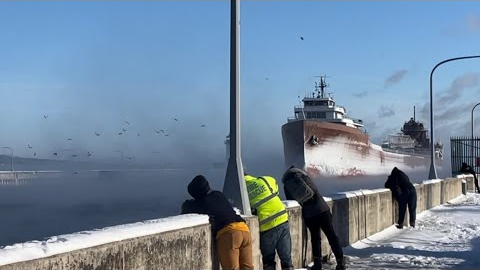A Grand Old Lady: The Great Lakes’ Historic War Hero Arrives for Winter in Spectacular Fashion
774 View
Share this Video
- Publish Date:
- January 15, 2024
- Category:
- Pearl Harbor
- Video License
- Standard License
- Imported From:
- Youtube
Tags

My favorite arrival of the entire season, and there’s almost too much to talk about here! For starters I don’t usually include any narrative within the video, but in this case I felt it was important to do so. I’ll add her full backstory here for anyone who may not be able to understand me, plus some additional details as well (since it’s hard to remember everything on the spot lol). While the Arthur M Anderson rightfully gained fame from her actions with the Fitzgerald, the Tregurtha’s history is even greater and often flies under the public’s radar.
The Lee A Tregurtha arriving in brutal -35 Degree (F) conditions, coming off the lake in majestic style, arriving covered in ice through a cloud of sea smoke and scattering the birds with a master’s salute. Probably the most spectacular arrival all season, not even considering the ship itself or the circumstances of her arrival. She came in for winter layup, sailing under the Blatnik Bridge twice to reach Fraser Shipyards dry dock, where she will sit until spring. Her arrival at Fraser is touched on here but will be covered more in a separate video as well.
Now for her history, and it’s extensive:
Built and commissioned on Christmas Eve, 1942 in Maryland, the then 501ft USS Chiwawa was the lead ship of her class. She was an oiler, an armed and armored oil taker designed to supply allies, fleets and ground forces with fuel and supplies. This made her a priority target for German and Japanese forces during the war, so she was also equipped with a 5 in (130mm) main turret (the same main batter gun as was equipped on destroyers of the day) as well as a dozen or so smaller anti-aircraft guns. With a crew of 213 and a hold full of oil, she set sail on her first voyage to the European Front. On the way, her convoy was ambushed by a pack of U-boats, and in the ensuing battle, they sank 4 vessels in her fleet and damaged others. The surviving ships escaped after aircraft arrived in time to chase the subs off. The next two years the Chiwawa would spend shipping fuel from North America to European and African ports, allowing for the fight to continue against the Nazis. In 1944 she escorted and refueled an invasion fleet leaving Italy and arriving in the south of France.
In early 1945 she sailed to New York for a quick refit, then sailed for the Pacific. She spend some time at Pearl Harbor before going to join the fleet for the battles of Ulithi and Okinawa, resupplying fuel to sea and ground forces. She then joined the 7th Fleet and was present in Tokyo Harbor during the Japanese surrender in September of 1945.
She sailed for the Navy another 6 months before being put into mothballs along with much of the US naval fleet, with no war on there was no need for so many vessels. She would sit for the next decade, waiting to be scrapped or used for a nuke testing target, but neither would happen.
Instead, between 1958 and 1961 (sources are not agreeing here) she was purchased by Cleveland Cliffs. Her pilothouse was moved from the center of the ship to the front, had her bottom lowed by 2ft and her sides widened by 7ft, while a 200ft mid section was built In Germany (ironically) and sailed across the Atlantic, while the ship was cut in half and the new section placed in the center. Now known as Walter A Sterling, the ship entered Great Lakes service as a straight decker. In 1976 she was laid up again, and had yet another extension added on, a 100ft mid section and a self-unloading boom were added, turning her into the 824ft ship seen today.
In 1985 the Cliffs company sold her to Ford’s Rouge Steel fleet, and renamed William Clay Ford. Just four years later, that company folded, and all its vessels were put up for auction. Most went to the scrapyards, but this one found a new home, being purchased by Interlake Steamship and renamed Lee A Tregurtha, after the wife of the company’s Vice Chairman, Paul R Tregurtha. In 2006 her aging original steam engines were replaced by modern diesel engines. More recently, exhaust scrubbers were added as well. She was laid up for much of 2020 due to the pandemic that year, but sailed out the next. In 2022 her interior was refitted, adding modern accommodations, air conditioning and a new galley, and her hull received some repairs, allowing her to continue sailing for the foreseeable future. In 2023 the Joseph H Thomson was retired and scrapped due to major hull issues, leaving Lee (I’m fairly certain anyways but please correct me if I’m wrong) as the very last remaining large US World War 2 naval vessel still active, and not scrapped or retired as a museum.
Should she ever be retired, I can think of no better ship (along with Arthur M Anderson) to receive the honor of being preserved as a museum. Only time will tell if that happens, but if it happens then it’s a goal worth trying to strive for! In the meantime have a genuine war hero staying in our port for the winter of 2024, and we wish her crew a wonderful off-season!













